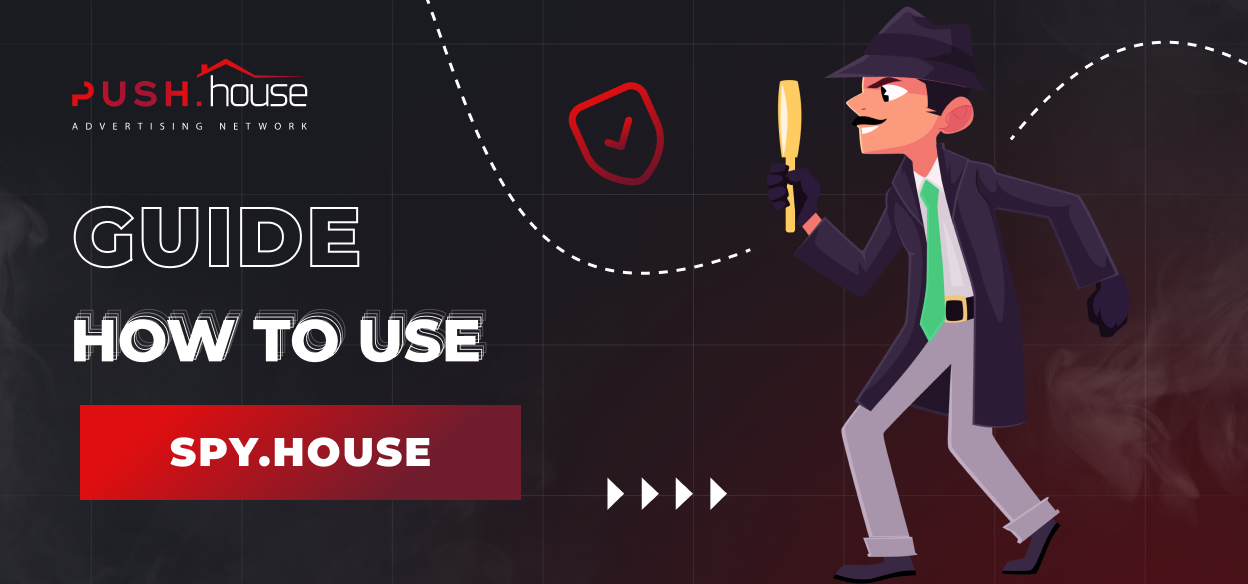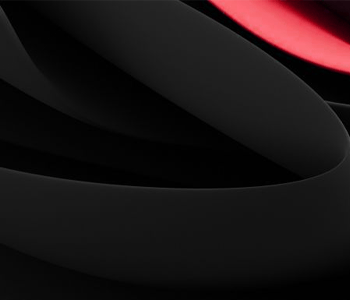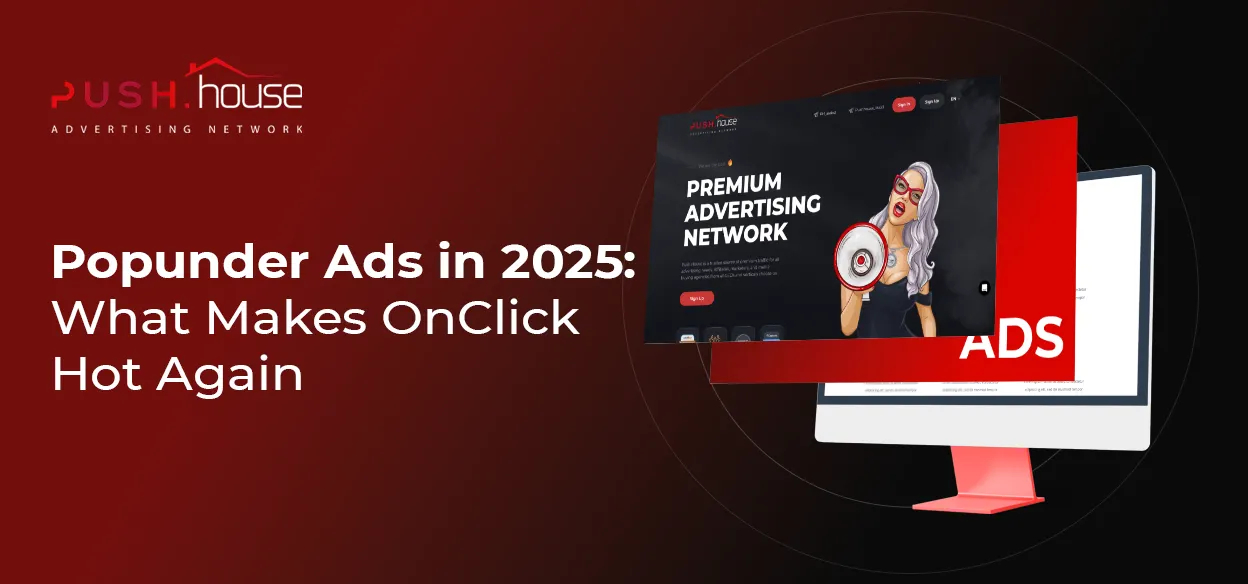
Types of Landing Pages
Hello! Push.House is here.
Promoting most verticals involves using a landing page as part of the campaign. Depending on the niche, advertisers use pages that warm up user interest and motivate them to take the desired action or run an ad campaign directly to a landing page, which serves as the offer’s showcase. In this article, we’ll discuss what landing pages are, the different types they come in, and how they can be used to attract traffic on Push.House.
What Is a Landing Page?
A landing page is an advertising web page that a user lands on after clicking on a push notification ad. Depending on the intended action and vertical’s specifics, landing pages can be of two types:
1. Landing Page
A landing page is a dedicated page promoting the advertised offer. It contains a description of the offer’s features and benefits, along with a direct call to action. In CPA marketing, a landing page serves as a full-fledged advertising offer.
A landing page is a single-page website. It differs from a regular website in terms of design and purpose. The goal of a landing page is to sell a specific product or service to a specific audience. Most landing pages feature just one button—either “Buy” or “Leave Your Contact.”
The classic structure of a landing page includes the following elements:
– Logo and offer name
– Description
– Price with all discounts and promotions
– Order form
– Answers to frequently asked questions
– Authenticity certificates
– Contact information for feedback
A landing page is essential for informing users about the offer and its advantages comprehensively. A typical landing page should answer the following questions:
– What’s included in the product?
– What success guarantees are there?
– What pain points does the offer address?
– Are there successful usage cases?
– How fast is the delivery?
– What’s the product’s cost?
– How is it used?
– Are there any side effects?
– Does the product have authenticity certificates?
These landing pages can be divided into several categories based on the offer’s specifics and the desired action:
- Selling Landing Page


A landing page with advertising information about the offer and its benefits. A selling landing page leads the user to take the desired action or fill out a feedback form for a subsequent purchase. Selling landing pages are actively used in promoting nutra and e-commerce verticals.
- Announcement Landing
A popular landing page format for promoting info courses, cryptocurrencies, educational programs, and online schools. It encourages users to subscribe, purchase a course, or place a pre-order.
- Scientific Research


The format of scientific research is the most common in landing page design. Advertisers who choose this approach often achieve high conversion rates by using images of experts and statistics that increase user trust of the landing page.
Scientific research landing pages can include both an announcement of a newly available product and a full-fledged promotional offer for it.
- Promotion


Promotions and discounts generate interest among users when they have doubts about the quality and effectiveness of the advertised offer. Landing pages with promotions and discounts inform the audience about the advantages of purchasing at a specific time, creating a sense of urgency that triggers order placements.
2. Pre-landing Page
A pre-landing page is a transitional website that motivates users to take the desired action. Usually, the information about the offer presented on the pre-landing page is in storytelling format (personal experiences, blogs, expert opinions, etc.). The pre-landing page’s task is to warm up users before they proceed to the main landing page for order placement. Achieving this is possible by creating a quality story and the right approach to designing the following landing page elements:
- Story
The story is the primary tool for attracting and retaining user attention. Depending on the offer’s specifics, content writing style, and the selection of characters and situations, it can vary. The primary criterion for evaluating a quality story is its simplicity and authenticity. Focusing on specific information blocks and the emotional content of the text immediately engages the audience and keeps users on the page for as long as possible.
A quality story is the foundation of many popular approaches to creating a pre-landing page. The overall success of promotion depends on the quality of its preparation and the precise use of triggers.
- Narrative Format
Surprisingly, audiences in many verticals are skeptical of high-quality advertising content, trusting more in user experiences with similar problems. The pre-landing page’s narrative format largely determines the initial level of trust and interaction with the user. The most popular formats include personal blogs, interviews, TV shows, or scientific research.
- Visuals
The images on a quality pre-landing page depend directly on the narrative format and its story. Personal blogs and “user-generated” content involve using the most “live” images, while expert materials require professionally designed statistical tables, graphs, and diagrams.
- Reviews and Comments
What do users trust most? Other users’ comments. It is believed that a section with reviews and comments helps users understand how real and reliable the information on the page is. However, review and comment sections are manually edited by advertisers and contain only the content that helps the user convert.
- Offer Information
Information about the offer may include not only a description of the product’s characteristics and the benefits of using the product but also expert comments, information about discounts, usage statistics, and authenticity certificates.
Advertising the offer on the pre-landing page occurs gradually. Information is provided in small portions to avoid triggering users. The pre-landing page’s task is to promote without overtly advertising.
- Interactive Elements
Various interactive elements that motivate users to take the desired action here and now. These elements are usually presented in the form of a timer, a wheel of fortune, a discount selection, or a chatbot. The presence of interactive elements significantly influences the final conversion of an advertising campaign.
Regardless of their functionality, each of these interactive elements immediately leads the user to take the desired action, most often to a purchase form, which involves filling out information and making a purchase or receiving a call from a call center.
Contact the Push.House manager to get started
- Order Form
Having an order form on a pre-landing page is not the primary requirement for this type of landing page. However, lately, this format has gained popularity among CPA advertisers.
A pre-landing page with an order form is identical to the classic pre-landing page format, however it also offers the user the opportunity to place an order after reading the story. This format is particularly popular in promoting nutra offers and helps reduce the sales funnel. Since some traffic may be lost during the transition to the landing page, using a pre-landing page with an order form is considered one of the most effective types of landing pages.
Most users perceive standard advertising offers as aggressive marketing, so they view them more negatively than native promotion. In such cases, users may not even realize they have entered a sales funnel. Ad campaigns with a pre-landing page with an order form frees advertisers from using a separate landing page, as all the warming up and order placement occur on one page.
Before presenting the order form on the pre-landing page, there must be a warm-up phase. The advertiser’s task at this stage is to maximize the potential customer’s interest and smoothly lead them to the order placement.
To retain user attention and convince them of the unique value of the offer, order forms are often presented in the form of interactive elements. The most popular order form formats include:
- Questionnaire


A small block with mandatory fields to fill out. To place an order, the user needs to provide their name, email address, and phone number. In some cases, the questionnaire may ask for card details to complete the purchase, bypassing a call from the call center.
- Discount Roulette


A popular interactive element that invites users to “try their luck.” Clicking on the roulette starts an animation. Depending on where the roulette stops, the user will be offered a corresponding discount. Spoiler: it always stops at the maximum.
- Secret Selection


Usually presented in the form of closed boxes or other interactive elements, each containing a “unique” discount. In terms of functionality, it resembles a classic no-lose lottery. Just like with the roulette, algorithms are set up so that the user ALWAYS receives the maximum discount.
- Chat
An interactive chat that implies “personal” communication between the user and an expert related to the offer. Thanks to previously defined conversation algorithms, the user is offered a unique discount and the opportunity to place an order quickly.
For a pre-landing page to work effectively and encourage users to take the desired action, especially important is its proper functioning. It’s not uncommon for pre-landings not to be adapted for mobile devices. When running advertising campaigns in Push.House using a pre-landing page, ensure its correct display in advance. Otherwise, there is a high chance of losing part of the traffic when transitioning to the landing page.
It’s also worth considering that in some regions, internet speed can vary significantly. The speed of page loading affects the success of promotion. Users who wait a long time for a page to load are more likely to leave. To prevent this, check the optimization quality of the pre-landing page before launching your advertising campaign.
Popular Approaches to Creating Pre-landing Pages
- News and TV Programs


This approach involves styling the pre-landing page to resemble a popular news resource or TV show that is well-liked in a particular region. Because of the audience’s familiarity with the resource, the pre-landing page gains increased trust and eliminates potential objections when users engage with the content.
- Celebrity


Popular opinion leaders, showbiz stars, actors, musicians, politicians, etc. This approach is most effective when paired with a story involving a similar problem experienced by the celebrity. Users develop a sense of authenticity in this solution to their problem, increasing trust in the resource.
- Expert Opinion


Users tend to trust figures with expertise in the areas related to the offer. Promoting an exchange, for instance, might work better if presented by a successful trader. Nutra offers are more effective when doctors or scientists are present on the pre-landing page.
- Personal Blog


Personal experiences described in a blog help boost user trust in the content due to its real-world applicability. Audiences in many verticals tend to trust the experiences of users who are not remarkably different from them in terms of earnings or other advantages.
- Before/After


A classic approach to promoting nutra verticals. Demonstrating the use of the offer visually allows the audience to see the results they can achieve after purchasing.
Pre-landing Page or Landing Page – What to Choose?
Unfortunately, there isn’t a clear-cut answer to this question. Much will depend on the vertical, the specifics of the offer, and the target audience it’s intended for. Nutra offers tend to convert better in cases where users go through a warming-up and content exploration phase before making an order, either directly or indirectly related to the offer. Recently, more and more advertisers are opting to launch pre-landing pages with an order form, bypassing the transition to a landing page. However, in the case of promoting gambling offers, a pre-land might not be necessary at all. The primary offer information is displayed on a single landing page. It’s believed that the fewer steps users need to take to alleviate their “pain,” the better.
Where to Find Target Pages
You can find quality pre-landing and landing pages in several ways:
1. From an Affiliate Network
Most affiliate networks offer ready-made target pages that have been tested through in-house media buying. Advertisers can use these to drive traffic. For unique, author-owned pre-lands, you can consult with your affiliate network manager.
2. Using a Spy Service
For finding converting target pages, Push.House advertisers can use the free competitor ad monitoring service, Spy.House. You can find a detailed guide on how to use the service.
Remember not to use promotional materials from a spy service directly without first making them unique. Copying a competitor’s setup entirely can lead to a budget loss.
3. Create Them Yourself
Previously, creating target pages required at least minimal web design and coding skills. In the era of neural networks, building a website has become much more straightforward. There are numerous online website builders that allow you to create unique target pages quickly and affordably.
When choosing a target page, consider the characteristics of your offer and your chosen promotion strategy. We allow the use of any pre-landings and landing pages that don’t violate the rules of our advertising network. To determine the most effective sales funnel for your advertising campaign, we recommend testing multiple promotion options. After gathering enough data, it will be easier to determine which approach converts best for your campaign.
Good luck!















